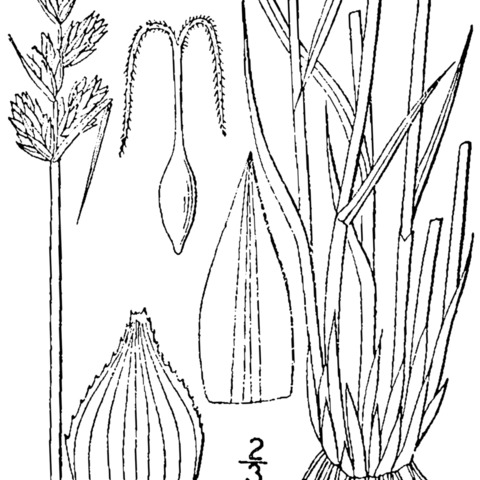Plants densely cespitose. Culms 25–80 cm. Leaves: sheaths adaxially hyaline, often green-veined nearly to collar, summits U-or V-shaped or rounded, sometimes prolonged to 1.5 mm beyond collar; distal ligules 1–4 mm; blades 2–5 per fertile culm, 7–25 cm × 2–3.5 mm. Inflorescences stiffly erect, dense or open, greenish brown to gold, 2–4.5 cm × 12–20 mm; proximal internode 2–15 mm; 2d internode 2.5–5 mm; proximal bracts leaflike, much longer than inflorescence, or bristlelike. Spikes 5–8(–11), usually distinct, broadly ovoid, 8–11 × 5–8 mm, base and apex acute to rounded. Pistillate scales reddish brown, with paler center, ovate to broadly ovate, 4–5.5 mm, equaling, ± covering perigynia, hyaline margin absent or to 0.2 mm, apex acute to mucronate. Perigynia ascending to spreading, green, gold, or cream colored, conspicuously 7–11-veined abaxially, conspicuously 0(–2)-veined adaxially, ovate to broadly ovate, plano-convex to biconvex, 4–5 × 1.9–2.5 mm, 0.7–1.1 mm thick, margin flat, including wing 0.2–0.6 mm wide, often thickened; beak gold at tip, flat, ciliate-serrulate, abaxial suture usually inconspicuous, distance from beak tip to achene 1.7–2 mm. Achenes obovate to elliptic, 2.1–2.5 × 1.6–2 mm, 0.7–1 mm thick. 2n = 78.
More
Densely tufted, aphyllopodic, 2–8 dm; main lvs surpassed by the stem, 3–4 mm wide; lowest bract dilated at base and often twice as long as its spike; spikes 4–15, gynaecandrous, 6–12 mm, subglobose, short-clavate at base, sessile and densely crowded in an ovoid or oblong cluster 2–3 cm; pistillate scales brown with narrow white-hyaline margins, largely concealing the perigynia; perigynia appressed-ascending or in age looser, oblong-ovate, strongly planoconvex, 4.2–5.2 mm, 2–2.5 times as long as wide, finely nerved dorsally, obscurely or scarcely so ventrally, narrowly serrulate-winged above the middle, merely sharp-edged below, rather abruptly narrowed to the flat, serrulate beak; achene lenticular, 2–2.5 × 1.5–2 mm; 2n=64. Dry, open places; Nf. to Mack., s. to N.Y., Mich., Minn., and B.C.

